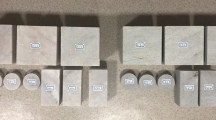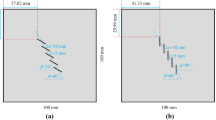Abstract
Experimental studies suggest that the fracture toughness of rocks increases with the confining pressure. Among many methods to quantify this dependency, a so-called burst experiment (Abou-Sayed, 1978) may be the most widely applied in practice. Its thick wall cylinder geometry leads to a stress state resembling the subsurface condition of a pressurized wellbore with bi-wing fractures. The fracture toughness of a sample, under a given confinement pressure, can be recovered from the critical pressure upon which the bi-wing cracks propagate. Traditionally, this critical pressure is thought to correspond to a sudden drop in injection pressure. However, as the standard configuration was deliberately designed to obtain stable fracture growth at the onset, propagation can take place well before this drop in pressure, and one may overestimate the fracture toughness from measured pressures. Here, we study crack stability in the burst experiment and propose modifications to the experimental design which promotes unstable fracture growth and makes the critical pressure less ambiguous to interpret. We found that experiments with the original, stable design can lead to inconsistent measurement of fracture toughness under confining pressure, while results from unstable configurations are more consistent. Our claim on the stability was also supported by the recorded acoustic emissions from both stable and unstable experiments.
Highlights
-
We analyzed stability of thick wall cylinder experiments for fracture toughness estimation under confining pressure known as the burst experpiment.
-
Our analysis demonstrated that fracture toughness may systematically be overestimated in the original burst experiment configuration.
-
We propose modifications to the burst experiment for a more accurate fracture toughness measurement.
-
Our experiments confirmed the superiority of the modified design for detecting the onset of fracture propagation and measuring the fracture toughness of a sample.







Similar content being viewed by others
References
Abou-Sayed AS (1978) An experimental technique for measuring the fracture toughness of rocks under downhole stress conditions. VDI Berichte 313:819–824
Balme MR, Rocchi V, Jones C, Sammonds PR, Meredith PG, Boon S (2004) Fracture toughness measurements on igneous rocks using a high-pressure, high-temperature rock fracture mechanics cell. J Volcanol Geotherm Res 132(2–3):159–172. https://doi.org/10.1016/S0377-0273(03)00343-3
Bažant ZP (1984) Size effect in blunt fracture: concrete, rock, metal. J Eng Mech 110(4):518–535. https://doi.org/10.1061/(ASCE)0733-9399(1984)110:4(518)
Chang S-H, Lee C-I (2004) Estimation of cracking and damage mechanisms in rock under triaxial compression by moment tensor analysis of acoustic emission. Int J Rock Mech Min Sci 41(7):1069–1086. https://doi.org/10.1016/j.ijrmms.2004.04.006
Chen M, Zhang G-Q (2004) Laboratory measurement and interpretation of the fracture toughness of formation rocks at great depth. J Pet Sci Eng 41(1–3):221–231. https://doi.org/10.1016/S0920-4105(03)00156-6
Clifton RJ, Simonson ER, Jones AH, Green SJ (1976) Determination of the critical-stress-intensity factor KIc from internally pressurized thick-walled vessels — the critical-stress-intensity factor of thick-walled rock specimens is determined from the pressure at failure. Exp Mech 16(6):233–238. https://doi.org/10.1007/BF02329274
Dubois F, Chazal C, Petit C (1998) A finite element analysis of creep-crack growth in viscoelastic media. Mech Time Depend Mater 2(3):269–286. https://doi.org/10.1023/A:1009831400270
Fialko YA, Rubin AM (1997) Numerical simulation of high-pressure rock tensile fracture experiments: evidence of an increase in fracture energy with pressure? J Geophys Res Solid Earth 102(B3):5231–5242. https://doi.org/10.1029/96JB03859
Fosdick, R., Truskinovsky, L. About Clapeyron's Theorem in Linear Elasticity. Journal of Elasticity 72, 145–172 (2003). https://doi.org/10.1023/B:ELAS.0000018757.56138.f3
Francfort GA, Marigo J-J (1998) Revisiting brittle fracture as an energy minimization problem. J Mech Phys Solids 46(8):1319–1342. https://doi.org/10.1016/S0022-5096(98)00034-9
Funatsu T, Seto M, Shimada H, Matsui K, Kuruppu M (2004) Combined effects of increasing temperature and confining pressure on the fracture toughness of clay bearing rocks. Int J Rock Mech Min Sci 41(6):927–938. https://doi.org/10.1016/j.ijrmms.2004.02.008
Gao Y, Detournay E (2021) Fracture toughness interpretation from breakdown pressure. Eng Fract Mech 243(February):107518. https://doi.org/10.1016/j.engfracmech.2020.107518
Gehne S, Inskip NDF, Benson PM, Meredith PG, Koor N (2020) Fluid-driven tensile fracture and fracture toughness in Nash point shale at elevated pressure. J Geophys Res Solid Earth 125(2):2019–018971. https://doi.org/10.1029/2019JB018971
Ghanbari N, Hosseini M, Saghafiyazdi M (2019) Effects of temperature and confining pressure on the mode I and mode II fracture toughness of cement mortar. Theor Appl Fract Mech 104(May):102361. https://doi.org/10.1016/j.tafmec.2019.102361
Hashida T, Ogikubo H, Takahashi H, Shoji T (1993) Numerical simulation with experimental verification of the fracture behavior in granite under confining pressures based on the tension-softening model. Int J Fract 59(1):227–244. https://doi.org/10.1007/BF02555185
Holder J, Morita N, Kenrick AJ, Thallak S, Gray KE (1993) Measurements of effective fracture toughness values for hydraulic fracture: Dependence on pressure and fluid rheology. In: SPE-25491-MS. https://doi.org/10.2118/25491-MS
Irwin G (1957) Analysis of stresses and strains near the end of a crack traversing a plate. J Appl Mech 24:361–364. https://doi.org/10.1115/1.4011547
Kataoka M, Mahdavi E, Funatsu T, Takehara T, Obara Y, Fukui K, Hashiba K (2017) Estimation of mode-I fracture toughness of rock by semi-circular bend test under confining pressure condition. Procedia Eng 191:886–893. https://doi.org/10.1016/j.proeng.2017.05.258
Li J, Zhang G, Liu M (2019) Experimental investigation on the effect of confining pressure on the tensile strength of sandstone using hollow cylinder tensile test method. Arab J Geosci 12(24):1–7. https://doi.org/10.1007/s12517-019-4797-y
Lu G, Gordeliy E, Prioul R, Aidagulov G, Uwaifo EC, Ou Q, Bunger AP (2020) Time-dependent hydraulic fracture initiation. J Geophys Res Solid Earth 125(3):2019–018797. https://doi.org/10.1029/2019JB018797
Müller W (1986) Brittle crack growth in rocks. Pure Appl Geophys 124(4):693–709. https://doi.org/10.1007/BF00879605
Papanastasiou P (1997) The influence of plasticity in hydraulic fracturing. Int J Fract 84(1):61–79. https://doi.org/10.1023/A:1007336003057
Perkins TK, Krech WW (1966) Effect of cleavage rate and stress level on apparent surface energies of rocks. Soc Pet Eng J 6(04):308–314. https://doi.org/10.2118/1540-PA
Roegiers J-C, Zhao XL (1991) Rock fracture tests in simulated downhole conditions. In: ARMA-91-221
Rubin AM (1993) Tensile fracture of rock at high confining pressure: implications for dike propagation. J Geophys Res Solid Earth 98(B9):15919–15935. https://doi.org/10.1029/93JB01391
Sato K, Hashida T (2006) Cohesive crack analysis of toughness increase due to confining pressure. Pure Appl Geophys 163(5–6):1059–1072. https://doi.org/10.1007/s00024-006-0060-2
Schmidt RA, Huddle CW (1977) Effect of confining pressure on fracture toughness of Indiana limestone. Int J Rock Mech Min Sci Geomech Abstr 14:289–293. https://doi.org/10.1016/0148-9062(77)90740-9
Shah KR, Labuz JF (1995) Damage mechanisms in stressed rock from acoustic emission. J Geophys Res Solid Earth 100(B8):15527–15539. https://doi.org/10.1029/95JB01236
Stoeckhert F, Molenda M, Brenne S, Alber M (2015) Fracture propagation in sandstone and slate-laboratory experiments, acoustic emissions and fracture mechanics. J Rock Mech Geotech Engi 7(3):237–249. https://doi.org/10.1016/j.jrmge.2015.03.011
Tanné E (December 2017) Variational phase-field models from brittle to ductile fracture: nucleation and propagation. PhD thesis, Université Paris-Saclay, École Polytechnique. https://pastel.archives-ouvertes.fr/tel-01758354
Tanné E, Li T, Bourdin B, Marigo J-J, Maurini C (2018) Crack nucleation in variational phase-field models of brittle fracture. J Mech Phys Solids 110:80–99. https://doi.org/10.1016/j.jmps.2017.09.006
Tanné E, Bourdin B, Yoshioka K (2022) On the loss of symmetry in toughness dominated hydraulic fractures. Int J Fract. https://doi.org/10.1007/s10704-022-00623-5
Thallak S, Holder J, Gray KE (1993) The pressure dependence of apparent hydrofracture toughness. Int J Rock Mech Min Sci Geomech Abstr 30(7):831–835. https://doi.org/10.1016/0148-9062(93)90031-8
Thiercelin M (1989) Fracture toughness and hydraulic fracturing. Int J Rock Mech Min Sci Geomech 26(3):177–183. https://doi.org/10.1016/0148-9062(89)91967-0
Vásárhelyi B (1997) Influence of pressure on the crack propagation under mode-I loading in anisotropic gneiss. Rock Mech Rock Eng 30(1):59–64. https://doi.org/10.1007/BF01020113
Winner RA, Lu G, Prioul R, Aidagulov G, Bunger AP (2018) Acoustic emission and kinetic fracture theory for time-dependent breakage of granite. Eng Fract Mech 199:101–113. https://doi.org/10.1016/j.engfracmech.2018.05.004
Zhao XL, Roegiers JC (1993) Determination of in situ fracture toughness. Int J Rock Mech Min Sci Geomech Abstr 30(7):837–840. https://doi.org/10.1016/0148-9062(93)90032-9
Acknowledgements
The authors are grateful for financial support from Chevron to conduct the experiments through a grant to the University of Pittsburgh. The initial stability analyses of the burst experiments were performed by Dr. Erwan Tanné and his contributions are greatly acknowledged. The experimental data used in this study can be requested to the corresponding author. The files generated for computational data are available at https://doi.org/10.5281/zenodo.6323745. Part of this work was conducted, while BB was the A.K. & Shirley Barton Professor of Mathematics at Louisiana State University (USA).
Author information
Authors and Affiliations
Corresponding author
Ethics declarations
Conflict of interest
The authors declare that there are no conflicts with this publication.
Additional information
Publisher's Note
Springer Nature remains neutral with regard to jurisdictional claims in published maps and institutional affiliations.
Appendix 1: Stress intensity factor computation
Appendix 1: Stress intensity factor computation
In the original burst experiment proposal, Abou-Sayed (1978) decomposed the problem into the jacketed (J) and the unjacketed problems (U) (Fig. 8) as
and for \(K_\mathrm {I}^{J*}\) and \(K_\mathrm {I}^{U*}\) computation, the results from Clifton et al. (1976) were used.
Approximated superposition of the burst SIF proposed in Abou-Sayed (1978)
Note that this decomposition is not exact, because the unjacketed stress intensity factor is not equivalent to the constrained stress intensity factor (\(K_\mathrm {I}^{U*} \ne K_\mathrm {I}^{C*}\)). Here, we computed all the stress intensity factors numerically using the \(G-{\theta }\) method (Dubois et al. 1998). Figure 9 compares \(K_\mathrm {I}^{J*}\) and \(K_\mathrm {I}^{U*}\) from the \(G-{\theta }\) method with the reported values from Clifton et al. (1976) and the results are in close agreement.
Comparison of computed SIF evolutions with \(\ell\) with Clifton et al. (1976)
Because the difference between Eq. (9) and Eq. (A1) amounts to the difference between the constrained and the unjacketed stress intensity factors (\(K_\mathrm {I}^{C*}\) and \(K_\mathrm {I}^{U*}\)), we computed the relative errors (\((K_\mathrm {I}^{U*} - K_\mathrm {I}^{C*})/K_\mathrm {I}^{U*}\) ) with various wall thicknesses (w) against fracture lengths in Fig. 10. The approximation in Eq. (A1) may be acceptable for long fractures (\(\ell >0.8\)), but the errors increase for short fractures.
Rights and permissions
Springer Nature or its licensor holds exclusive rights to this article under a publishing agreement with the author(s) or other rightsholder(s); author self-archiving of the accepted manuscript version of this article is solely governed by the terms of such publishing agreement and applicable law.
About this article
Cite this article
Yoshioka, K., Zhang, Y., Lu, G. et al. Improving the Accuracy of Fracture Toughness Measurement in Burst Experiments. Rock Mech Rock Eng 56, 427–436 (2023). https://doi.org/10.1007/s00603-022-03097-y
Received:
Accepted:
Published:
Issue Date:
DOI: https://doi.org/10.1007/s00603-022-03097-y







